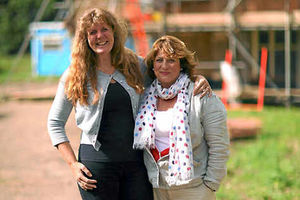Restoration Home - TV review
Anyone dreaming of owning a centuries-old character property would have probably run screaming to the nearest new-build site after watching Restoration Home last night.

Anyone dreaming of owning a centuries-old character property would have probably run screaming to the nearest new-build site after watching Restoration Home last night.
The show, which follows owners of historic properties as they restore them into luxury 21st century homes, did not end happily.
The Old Manor in Norfolk was a sprawling house of horrors, plagued by damp, woodworm and the ominously-monikered deathwatch beetle, and things only got worse.
The show would have been a joyless slog were it not for the charm of the fifty-something couple who bought the house. Hippy-ish solicitor Polly was delightfully optimistic about the project throughout, even as the dream morphed into a nightmare.
French husband Erich, a retired forensic psychologist, admitted he thought the house looked like a "ruin" at first but was soon bewitched by its fragile old beams.
The Grade II listed manor certainly had character, boasting a hotch-potch of architectural styles. Polly, who admitted she visited up to 300 properties in her search for the ideal home, fell in love with it instantly, swooning over its magnificent chimney stacks and beautiful oak panelled interior.
"It's a bit like a little old lady waiting for a facelift and we're coming in to make her better," she gushed. But this little old lady needed a life-saving operation.
Polly bought the house for £400,000 and the couple put their Liverpool home on the market as they prepared to move nearer to their grandchildren.
However, a catalogue of problems quickly unfolded. On closer inspection, it was revealed that 1960s concrete render had stopped the manor's old beams from breathing, leading to dry rot and woodworm.
Ever the optimist, Polly started pondering where to put her enormous dining table.
But more problems were to follow. As the roof was stripped bare and render removed, the builders discovered death-watch beetles had turned the wood to honeycomb, and the timber needed replacing. It was also revealed that the render was the only thing helping the house stay standing. Now the building was unstable.
Polly had initially estimated she would have to spend £200,000 to £300,000 on the restoration but was later forced to admit it might rise to £400,000.
Historian Kate Williams tried to lighten the mood by doing some research on the building's roots. The manor was once called Page's Place and was the home of philanthropist Edward Goffe.
It was built in the late 1500s to early 1600s but had been spruced up in the 18th or 19th century with a stained glass window salvaged from a church, and an archway bearing a Tudor coat of arms. The history lesson was a mild distraction from the miserable task of trying to make the building habitable.
To make matters worse, the finances were drying up as the house in Liverpool was failing to sell. As if that wasn't bad enough, the Old Manor was then broken into and wrecked by raiders. Ceilings were ripped open and a wall was kicked in.
This made Polly even more determined to see the project through, although a sadness was beginning to appear behind her smile. Asked by Caroline Quentin how she could remain so upbeat, she replied brightly: "I'm a glass three-quarters full girl, always have been."
Good job really, otherwise she would have been on her knees and sobbing among the decaying ruins. By the end of the show, the skeletal manor was still covered in scaffolding and plastic sheeting, bringing to mind the opening quote in David Lynch's eerie Twin Peaks series: "She's dead.
Wrapped in plastic." Maybe Polly needs to give up the ghost.
Heather Broome





